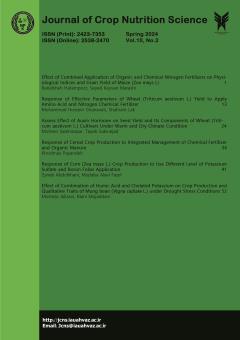Assess Effect of Auxin Hormone on Seed Yield and Its Components of Wheat (Triticum aestivum L.) Cultivars Under Warm and Dry Climate Condition
Subject Areas : Journal of Crop Nutrition ScienceMohsen Salehinazar 1 * , Tayeb Sakinejad 2
1 - Msc. Graduated, Department of Agronomy, Ahvaz Branch, Islamic Azad University, Ahvaz, Iran.
2 - Assistant Professor, Department of Agronomy, Ahvaz Branch, Islamic Azad University, Ahvaz, Iran.
Keywords: Crop production, Genotype, Harvest index, Seed weight, Spike,
Abstract :
BACKGROUND: Growth regulators are organic substances besides nutrients, synthesized in plants, causing alteration in their cellular metabolism. Synthesis of some plant hormones is adversely affected by environmental factors, which causes restriction on physiological processes of the plant and ultimately, limits their growth potential. OBJECTIVES: Current research was done to evaluate plant growth regulator (Auxin Hormone) on crop production of Bread Wheat cultivars. METHODS: This study was conducted via split plot experiment based on completely randomized block design (RCBD) with three replications. The treatments included wheat cultivars at three levels (Chamran 2, Behrang and Mehregan) and auxin hormone at three levels (including zero or control, 50 ppm and 100 ppm.ha-1), which were placed in the main and sub plots, respectively. RESULT: According result of analysis of variance effect of Auxin, cultivar and interaction effect of treatments (instead harvest index, number of seed per spike and 1000 seed weight) on all studied traits was significant at 1% probability level. Evaluate means comparison result indicated in different level of cultivar the maximum harvest index, number of seed per spike and 1000 seed weight was noted for Chamran 2 and minimum of that belonged to Mehregan cultivar. Compare different level of Auxin Hormone showed that the maximum and the minimum amount of harvest index, number of seed per spike and 1000 seed weight belonged to 100 ppm and control treatments. Assess means comparison result of interaction effect of treatments indicated maximum seed yield, biologic yield and number of spike per m2 was noted for Chamran 2 and 100 ppm Auxin hormone and lowest ones belonged to Mehregan cultivar and nonuse of auxin treatment. CONCLUSION: Finally, according result of current research foliar application 100 ppm Hormone with Chamran 2 Cultivar achieve highest amount of seed yield and its components and can be advised to producers in studied region.
Davani, D., M. Nabipour. and H. Roshanfekr Dezfouli. 2017. Effect of cytokinin and auxin hormones on yield and dry matter remobilization of corn in different planting patterns under saline conditions. Environmental Stresses in Crop Sci. 10(1): 105-118. (Abstract in English)
Emam, Y., H. Karimzadeh Sureshjani, S. Moori. and K. Maghsoudi. 2013. Yield response of Bread and Durum Wheat to different levels of Auxin and Cytokinin appli-cation under terminal drought stress conditions. J. Crop Prod. Proc. 3(8): 93-104. (Ab-stract in English)
Fahad, S., S. Hussain, A. Bano, S. Saud, S. Hassan, D. Shan, F. A. Khan, F. Khan, Y. Chen. and C. Wu. 2015. Potential role of phytohormones and plant growth-promoting rhizobacteria in abiotic stresses: consequences for changing environment. En-viron Sci. Pollut. Res. 22: 4907-4921.
Fitals, S. 2016. Assess response of seed yield and its components of Broad bean to dif-ferent level of Gibberellin acid. Sharmano Univ. 111 pp.
Gardner, F. P., R. B. Pearce. and R. L. Mitchell. 1985. Physiology of crop plants. Ames, IA: Iowa State Univ. Press. USA. 121 pp.
Ibrahim, M. E, M. ABekheta, A. El-Moursi. and N. A. Gaafar. 2007. Improvement of growth and seed yield quality of Vicia faba L. plants as affected by application of some bioregulators. Aust. J. Basic and Appl. Sci. 1(4): 657-666.
Keshavarzi, M. S., B. Jafari Haghighi. and A. R. Bagheri. 2014. The evaluation of auxin and gibberellin hormone on quantitative and qualitative characteristics of forage corn. J. Plant Eco-Physiol. 5(15): 26-35. (Abstract in English)
Khalaf, A. S. and A. S. A. Al-Rajbo. 2006. Seed technology. Dar Ibn Al Atheer Print-ing and Publishing. University of Mosul. Iraq.
Kolachevskaya, O. O., S. N. Lomin, D. V. Arkhipov. and G. A. Romanov. 2019. Auxins in potato: Molecular aspects and emerging roles in tuber formation and stress resistance. Plant cell reports. 38(6): 681-698.
Mahrokh, A., M. Nabi Pour, H. A. Roshanfekr Dezfuli. and R. Choukan. 2016. Evaluation of relationship between Auxin and Cytokinine hormones on yield and yield components of Maize under drought stress condition. Iranian J. Field Crops Res. 14(2): 266-278. (Abstract in English)
Naeem, M., I. R. A. M. Bhatti, R. H. Ahmad. and M. Y. Ashraf. 2004. Effect of some growth hormones (GA3, IAA and kinetin) on the morphology and early or delayed initiation of bud of lentil (Lens culinaris Medik). Pakistan J. Bot. 36(4): 801-809.
Patarx, Z. 2019. Evaluation effect of Growth hormone (Gibberellin Acid) on Seed yiels and its components of Vicia faba under salinity stress condition. Msc. Thesis. Otarpabon Univ. 123 pp.
Rastogi, A., A. Siddiqui, B. K. Mishra, M. Srivastava, R. Pandey, P. Misra, M. Singh. and S. Shukla. 2013. Effect of auxin and gibberellic acid on growth and yield components of linseed (Linum usitatissimum L.) Crop Breed. Appl. Biotech. 13: 136-143.
Tianam, X. 2019. Investigation effect of different level of gibberellin hormone on growth indices and crop production of broad bean. Res. Rep. Carlan Agri. Res. Org. 61 pp.
Toreti, A., O. Cronie. and M. Zampieri. 2019. Concurrent climate extremes in the key wheat producing regions of the world. Sci. Reports. 9(1): 1-8.
Zand, B., A. Sorooshzadeh, F. Ghanadi. and F. Moradi. 2014. Effect of zinc (Zn) and auxin (IBA) foliar application on phytohormonal variation and growth of Corn (Zea mays L.). Iranian J. Plant Biol. 6(22): 63-76.
Zianto, S. 2016. Assess crop production of broad bean affected different level of gib-berellic acid. Msc. Thesis. Patral Univ. 105 pp.

